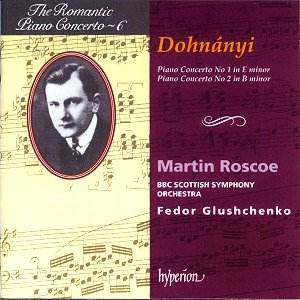The Hungarian composer Ernst (Ernö) von Dohnányi
is well known in his homeland but less celebrated internationally. Over
the years his most famous composition has been another piano concerto,
the Variations on a Nursery Song, but in truth he was prolific,
and was admired by fellow musicians from the time of Brahms (whom he
knew) through to his final years in the United States.
As a young man Dohnányi was a virtuoso pianist,
and it shows in his Piano Concerto No. 1, which he composed in
1897-98. It is nothing if not substantial in scale, lasting for a full
45 minutes, and cast in the conventional three-movement design with
the slow movement at the centre. The style is very much of its time,
with a full awareness of Liszt and Brahms, but without the challenging
qualities of the harmonic language of Bartók.
There is an heroic, almost epic quality about the outer
movements, both of which approach 20 minutes in duration. This puts
a strong demand upon the soloist, of course, and in this sense Martin
Roscoe does not disappoint. For he is a splendid pianist, who sounds
very much inside the music and thoroughly in command of the technique
required. If there is a criticism of the performance it is probably
more to do with the balancing of piano and orchestra, since the solo
piano does sometimes sound swamped by the massive orchestral sound,
and details of articulation can disappear. Of course Dohnányi's
skilful orchestration does not always place this consideration uppermost
on the agenda, and in a movement of the size and scale of the opening
Allegro maestoso there are many turns of direction and manner.
In the First Concerto the slow movement is perhaps
the best. A brave and imaginative touch in the orchestration is that
the strings play pizzicato for most of the time, while the melodic shaping
is derived in large part from a subtle transformation of first movement
material. It is all particularly well judged, and Roscoe plays with
care and taste in every bar.
The finale returns to the heroic epic scale, and becomes
more compelling as it reaches its final stages. Here Roscoe and the
orchestra sweep the music on to a particularly exciting conclusion,
just what the romantic piano concerto is all about.
There are fifty years between these two concertos,
though the listener would not know it from the music. The Piano Concerto
No. 2 was completed in 1947. It remains romantic in style (thus
justifying its position in Hyperion's series), but the construction
seems tighter than that of its earlier companion, and it is none the
worse for that. This is reflected in the length, which comes out at
around the 30 minute mark.
Again there are three movements in the traditional
sequence, but the large first movement dominates the work, forming a
half of its duration. Dohnányi opens with a theme which he develops
obsessively, in the style of a motto, but there is also room for more
indulgent lyric romantic gestures. The artists manage these contrasts
well, maintaining the flow and convincing the listener of the structural
purpose.
In his useful insert notes, the distinguished musicologist
Otto Karolyi refers to the slow movement as occupying 'a stylised Hungarian
gypsy style'. But it is not an indulgence, for in the final two movements
the unity of the conception is a real priority, as the motto returns
and the lively finale emerges as the only possible conclusion for the
whole work. Again Roscoe is a convincing interpreter. Of the two concertos,
the more carefully constructed Second is probably the more compelling,
but the experience both works offer is thoroughly satisfying, and wholly
justifies Hyperion's foray into this little known territory.
Terry Barfoot
Complete
Hyperion Romantic Piano Concert series


